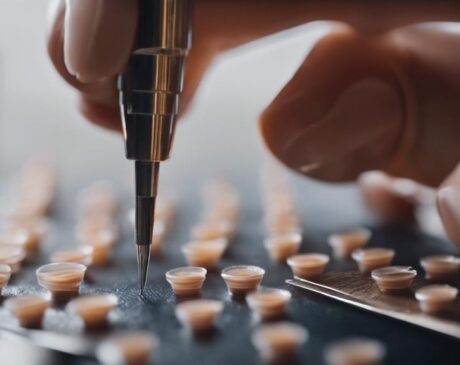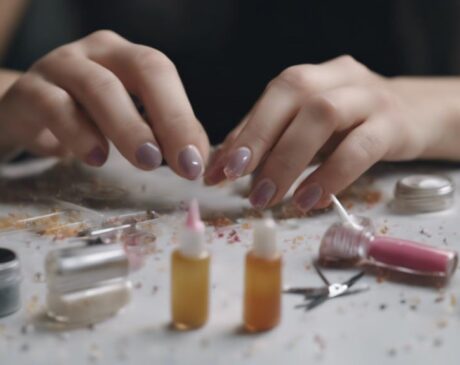What can I use if I don’t have nail glue for fake nails?

Nail glue is a specialized adhesive used primarily for applying false nails and repairing natural nails. It typically contains cyanoacrylate, a fast-drying adhesive that forms a strong bond with the keratin in natural nails. This ingredient ensures that artificial nails adhere securely for weeks, creating a seamless and natural look that can withstand daily activities.
Why Look for Alternatives?
Despite its effectiveness, some individuals seek alternatives to traditional nail glue for various reasons. Allergic reactions or sensitivities to the chemicals in standard nail glue, concerns about potential damage to natural nails, and the unavailability of nail glue can all drive the search for alternatives.
Best Alternatives to Nail Glue
Double-Sided Tape
Double-sided tape offers a quick and easy alternative to nail glue. This method involves cutting small pieces of tape to fit the size of artificial nails and pressing them onto the nail bed. While not as long-lasting as traditional nail adhesive, double-sided tape provides a temporary solution suitable for short-term wear, such as for events or photo shoots. Its primary advantage lies in its ease of application and removal, making it a less damaging option for natural nails.
Press-on Adhesive Tabs
Press-on adhesive tabs are another popular alternative to nail glue. These pre-cut adhesive tabs are designed to fit various nail sizes and shapes. To use them, peel off the backing, place the tab on your natural nail, and press your fake nail onto it. Adhesive tabs offer a stronger hold than double-sided tape and can last for days when applied correctly. They are also gentler on natural nails and can be easily removed by soaking them in warm water.
Clear Polish as an Adhesive
Using clear polish as an adhesive is an innovative way to apply fake nails without traditional glue. This method involves applying a layer of clear polish to your natural nails and quickly placing the fake nails on top while the polish is still wet. Once the polish dries, it forms a bond between the fake and real nails. While not as strong as nail glue, this method holds the nail in place for a few days and adds an extra layer of shine to enhance the overall manicure’s appearance.
DIY Nail Glue Solutions
Homemade Nail Glue Recipe
Homemade nail glue is a viable option for those who prefer a more natural approach or are on a budget. To create your own nail glue, you’ll need simple ingredients commonly found at home:
Ingredients:
- 1/2 teaspoon of PVA glue (white school glue)
- A few drops of clear nail polish
Preparation:
- In a small bowl, mix the PVA glue with a few drops of clear nail polish. The nail polish helps make the mixture stickier and more durable.
- Stir the mixture until it reaches a uniform consistency.
- Use a small brush or toothpick to apply this homemade glue to your natural or fake nails.
- Press the fake nail onto the real nail and hold it for a few seconds to ensure a strong bond.
- Keep in mind that this homemade glue is a temporary solution and may not last as long as commercial nail glue.
Safety and Precautions
When using any adhesive, whether homemade or commercial, it’s essential to follow safety precautions to protect your nails and skin:
- Allergic Reaction Test: Before applying the adhesive to your nails, perform a patch test on your skin to check for any allergic reactions.
- Avoid Skin Contact: Apply the glue only to your nails, avoiding contact with the surrounding skin to prevent irritation.
- Work in a Ventilated Area: Ensure good ventilation to avoid inhaling any fumes from the glue or polish.
- Keep Away from Eyes: Be cautious not to let the glue come into contact with your eyes.
Tips for Applying Fake Nails without Using Nail Glue
Preparing Your Nails
Properly preparing your natural nails is crucial for the longevity and appearance of your fake nails:
- Clean Your Nails: Ensure that your nails are clean and free of any polish or oil. Use a nail polish remover if necessary.
- Polish the Surface: Lightly polish the surface of your natural nails to create a slightly rougher texture, improving adhesion.
- Apply Base Coat: Use a clear base coat to protect your natural nails and provide a better gripping surface for the adhesive.
Apply Alternatives Effectively
To achieve the best results when using nail adhesive alternatives:
- Apply Evenly: Whether using double-sided tape, adhesive tabs, or homemade glue, ensure even application onto the nail.
- Press Firmly: After placing the fake nail, press firmly for a few seconds to ensure a secure bond.
- Avoid Water Contact: After application, refrain from submerging your hands in water for at least a couple of hours to allow the adhesive to set properly.
Advantages and Disadvantages of Nail Adhesive Alternatives
Advantages of Using Alternatives
Alternatives to traditional nail glue offer several advantages:
- Less Damage: These alternatives are usually less damaging to natural nails, reducing the risk of weakening or damage.
- Easy Removal: They can often be removed more easily without the need for harsh chemicals.
- Ease of Use: These alternatives can be a lifesaver when nail glue is unavailable, providing a convenient solution.
Potential Drawbacks
However, there are some limitations to consider:
- Reduced Durability: Alternatives may not provide as long-lasting a bond as commercial nail glue.
- Inconsistent Results: Results may vary depending on the type of alternative used and the application technique.
- Potential for Allergic Reactions: Just like traditional nail glue, there is always a risk of an allergic reaction, so patch testing is required before use.
In conclusion, while nail glue remains the standard for applying fake nails, several viable alternatives can be used in its absence. These include double-sided tape, press-on adhesive tabs, clear polish, and homemade nail glue, each with its unique benefits. These alternatives are best suited for short-term use or situations where a less permanent solution is needed. By understanding the pros and cons of each option, you can make an informed decision for your nail care routine.
Frequently Asked Questions
Can I use regular adhesive instead of nail glue?
Using regular adhesive, such as Power Gel, instead of nail glue is not recommended. Power Gel is not formulated for use on the body and can irritate the skin, damage natural nails, and be difficult to remove.
How long do these alternatives last compared to traditional nail glue?
The longevity of these alternatives varies, but typically they do not last as long as traditional nail glue. For example, double-sided tape and press-on adhesive tabs may last a few days, while homemade nail adhesive may last slightly longer depending on application and nail care. However, none of these alternatives usually match the weeks-long lifespan of traditional nail glue.
Are there any health risks associated with using these alternatives?
The health risks associated with these alternatives are generally lower compared to traditional nail glue, especially in terms of harsh chemicals. However, it’s still important to do a patch test for allergic reactions and use them in a ventilated area to avoid inhaling any fumes.
Can these alternatives be easily removed?
Yes, one of the advantages of these alternatives is that they are usually easier to remove compared to traditional nail glue. Soaking the nails in warm water or using a gentle nail polish remover can often do the trick.
What is the most cost-effective alternative to nail glue?
The most cost-effective alternative to nail glue is likely homemade nail glue, as it can be made with common household items like PVA glue and clear nail polish. This option is not only affordable but also easily accessible.




